Elizabeth Fortescue
Elizabeth Fortescue is the visual arts writer for the Daily Telegraph, Sydney, and Australian correspondent for The Art Newspaper, London
Homepage: http://www.artwriter.com.au
Posts by Elizabeth Fortescue
Fiona Hall talks to ArtWriter about her Artist Award
Sep 21st
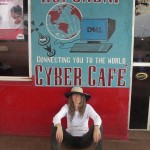
Fiona Hall is an endlessly inventive Australian contemporary artist whose chief inspiration is the natural world and humankind’s impact upon it. Hall was honoured on September 15, 2011, with a gala dinner at the Art Gallery of NSW where she received an award “in recognition of her outstanding achievement in the visual arts through a comprehensive body of work”. ArtWriter interviewed Fiona two days prior to the award, which was conferred by the Melbourne Art Foundation, a not for profit organisation dedicated to promoting contemporary art and living artists. Previous recipients of the Artist Award include John Mawurndjul, Peter Booth and James Gleeson. I did a story on Fiona for the Daily Telegraph. Here is an edited version of our entire interview.
ArtWriter: How was it to be the recipient of this award?
Fiona Hall: It’s a great honour [to receive the award]. You live in your own world, and try to interact with the world at large from your own creative and odd perspective of the world and you never really know what effect the outcome of the works will have on people. So it’s gratifying. Not undeserving, but humbled. Because in a sense it’s an honour for what I would probably be doing whether anyone ever paid any attention or not, to be quite honest.
Do you still feel, even though you’ve achieved success, that you can work in your own bubble?
Yeah, I would say I feel more than ever that way. On the one hand I’ve made a lot of associations in different walks of life through being an artist, which has been fantastic, and I’ve had a number of wonderful opportunities to travel to places and in ways I never would have expected to go. So all that’s been fantastic. But in a sense it would be incorrect to say I still feel I’m at ground zero in terms of setting out making artwork. I still feel there’s an immense amount of exploration to be done. It’s not like I’ve got to a certain point in life, with either my biological age or my career, where I feel I’ve been there and done that and jaded by the point that I’ve reached. I feel actually more driven. It’s funny. I don’t think I’m alone in that. [Fiona spoke about indigenous artists she had seen working in Broome, in WA.] They’re driven. I have an enormous amount of respect for that, because that’s the place where the work needs to come from.
One of the exciting places that life’s taken me a couple of years ago now is to eastern Arnhem Land to the Blue Mud Bay community to work on an etching project alongside artists from there, and I could see the same thing there, particularly with the older artists. You’re not really slowing down, you might be in some ways, but you’re more driven in other ways. You feel life from a new perspective and you feel more articulate in what you want to say about it as an artist.
Did you work alongside elder, Djambawa Marawili, at Blue Mud Bay?
Yes. He was the spearhead of our project. They won their landmark native title case over their sea rights, so they’re an important community indeed in the Arnhem Land area.
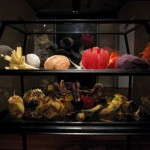 When were you in Blue Mud Bay?
When were you in Blue Mud Bay?
It would have been about this time 2009, just before the wet set in. And then we’ve done an etching project called Djalkiri which means “we are standing in their footsteps”. And it’s a group portfolio of the work of eight of us, including Djambawa. It’s travelling. Will do the rounds of the country in the next couple of years. We had the anthropologist Howard Morphy and also the ethnobiologist from the Darwin Herbarium, Glenn Wightman, accompanying us.
These projects come up when you’ve achieved a certain level of recognition.
Yeah. Another one I have to mention because it’s so exciting, I went as a surrogate New Zealand artist on a NZ Navy ship from Auckland to Tonga along what’s called the Kermadec Trench this May. It was funded by an American philanthropic group who have done lots of marine ecology work. They’re called PEW. They’re apparently an immense philanthropic funding body in the USA. They and some other science and environmental groups are trying to get the whole Kermadec Trench, which is in New Zealand waters, made a marine reserve to protect it from mining and fishing. It was a fantastic trip. We had the NZ minister for conservation on the boat. It was sort of quite political. So that’s all happening now in the lead-up to the NZ elections in late November. We’ve got a show that opens about the same time. That was amazing. Now we’re all making works for that. It was very inspiring.
The Kermadec Trench?
You know the so-called Pacific Rim of Fire, where all the earth’s tectonic plates meet and they’re the earthquake fault lines obviously. For me it’s a bit like that song about your leg bone being connected to your hip bone. Basically, on the western side of the pacific what with poor Christchurch and tragic japan, the Kermadec Trench is one link in that and it’s in New Zealand waters. So it’s a fault line along the Australasian ad Pacific tectonic plates and of course Australia’s on the Australasian plate but New Zealand actually straddles both plates. And then there are other trenches that join it that go up through the eastern seaboard of Japan and down the western side of the USA. The Kermadec Trench is the second deepest trench on the planet. It goes down 10,000 metres. There are more than 30 active volcanoes down there. All sorts of creatures which live far below the level at which daylight can possibly reach have evolved to cope with the toxicity [down there]. Many of those creatures are as yet unknown to science, as they say. Because of the volcanic activity and these underwater vents, there’s actually gold and precious metals deep down there so you can see why the mining industry is circling like sharks wanting to get in there. So PEW thought it would be good to send some artists along. There’s already been some good publicity raised because of our trip, so that’s a good thing. That’s the exciting end of being an artist for me.
What kind of works are you doing from that trip?
Well I shot a bit of video. Our destination point was Tonga at the north eastern end of the Kermadec Trench and I began working with tapa there. Some of the women artists showed me the tapa process. It’s a process of painting with natural dyes and ochres on bark cloth which they make from the bark of the paper mulberry tree which they beat up to form thin sheets. It’s a major art form in the Pacific, from Hawaii all the way through the western Pacific and to New Guinea as well. I’m working on tapa, I’m making 3D objects, or trying to, what with other agendas. Just trying to find enough time for all the ideas.
(Fiona said her next show will be at Roslyn Oxley9 in Sydney in November.)
There’s a parallel project which is for Documenta in Kassel in Germany next year. So that’s my other main agenda at the moment. The Kermadec Trench and Documenta.
What are you doing for Documenta?
I’m doing work that brings together environmental pressures and alludes to politics and the military. And it will be an installation. That’s probably the best way to describe it at present.
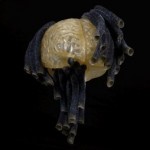 Do you have an assistant?
Do you have an assistant?
No, I do it by myself. It’s very slow. But actually what I get done in an hour or a day or a week seems to be often a pitiful amount. Often it’s very manual work. Because I’m actually making stuff as I go. Because I have a plan in my head, it would be difficult to explain to someone what that idea is. There’s a lot of thinking as I go. There’s not like a set plan that someone could follow on my behalf. And because it is so slow and so laboured, If someone paid me hourly to do the labour, you’d decide there’s better things to do in life. So I just do it all myself. And that’s where you’re driven. Different artists have different ways of working that works well for what they’re trying to achieve. But often I think about it like shooting an arrow at a target and the trajectory of the arrow while it’s travelling towards the target, you can readjust that as you go to try and make sure it hits the target, not off centre. And in a sense you have to have very close control over your work to do that. [Fiona said she works with specialists when she needs something cast or printed and editioned].
I remember interviewing you years ago at the AGNSW when you were knitting objects out of video tape.
Yeah, exactly. Someone said to me once, can you get knitting patterns to knit an arm! I wish, you know? If you could get a knitting pattern you could give it to somebody else. But particularly because you’re trying to knit each unit to be individual, not just carbon copies of each other, that’s a very good example.
Elizabeth Fortescue, September 19, 2011
Callan Park Gallery in Sydney’s Inner West, home to Outsider Art
Jun 19th
Artwriter was happy to write a catalogue essay for a recent exhibition of Outsider Art at the Callan Park Gallery in the grounds of the Sydney College of the Arts. SCA, of course, is part of Sydney University and its Dean is Colin Rhodes, a specialist in the field of Outsider Art and the author of a book on the subject.
The SCA and the Callan Park Gallery are both located in the open parkland of Callan Park, Rozelle, where people walk their dogs and take advantage of one of Sydney’s loveliest open spaces.
The exhibition for which I wrote the catalogue essay was Studio ARTISTS Untitled, and featured the work of five artists from a new collective known as Studio ARTISTS.
Click here to read the essay and see the Studio ARTISTS work. Click here for a link to a good site called Other Academies.
Elizabeth Fortescue, June 19, 2011
What would Monet have said? “C’est belle, Catherine!”
Jun 8th
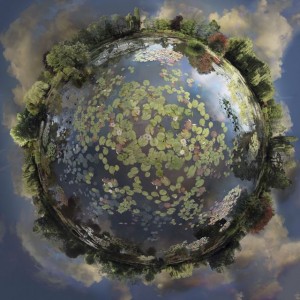 Catherine Nelson’s photographs in her latest exhibition titled Future Memories at Dominik Mersch Gallery (until July 2, 2011) can only be described as visually enchanting.
Catherine Nelson’s photographs in her latest exhibition titled Future Memories at Dominik Mersch Gallery (until July 2, 2011) can only be described as visually enchanting.
The photographs, like Monet’s Garden, shown at left, are a bit like looking up at the sky through the oculus in a 16th Century cathedral.
They remind me of the illustrations done by Antoine de Saint-Exupéry for his timeless novella, The Little Prince. I have reproduced a copy of the cover below so you can see what I mean.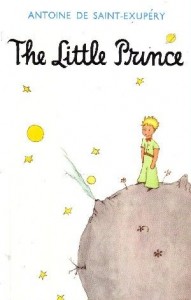 The photograph of Monet’s garden is typical of the works in the show. I’ll bet it’s a view of the garden that old Monet never imagined would be possible. And I’m sure he would be delighted and enthralled to see his garden as it has never been depicted. Like a watery, weightless bubble, the lake and surrounding greenery become a world of their own. We come across this little world as though we have journeyed through the sky and suddenly seen it. If we step aboard we will be the only one there, free to explore.
The photograph of Monet’s garden is typical of the works in the show. I’ll bet it’s a view of the garden that old Monet never imagined would be possible. And I’m sure he would be delighted and enthralled to see his garden as it has never been depicted. Like a watery, weightless bubble, the lake and surrounding greenery become a world of their own. We come across this little world as though we have journeyed through the sky and suddenly seen it. If we step aboard we will be the only one there, free to explore.
The exhibition is part of the Head On Photo Festival. I couldn’t resist adding it to my website.
Elizabeth Fortescue, June 8, 2011
Ballerinas and helicopters: Shaun Gladwell talks about his new ACMI exhibition
Jun 4th
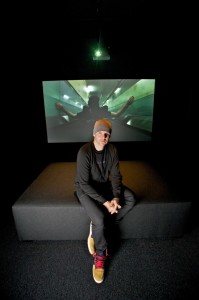 In March, 2011, I interviewed Shaun Gladwell for The Art Newspaper. The interview took place by telephone between me in Sydney and Shaun in London, where he had recently set up a new home and studio, having moved there from Australia.
In March, 2011, I interviewed Shaun Gladwell for The Art Newspaper. The interview took place by telephone between me in Sydney and Shaun in London, where he had recently set up a new home and studio, having moved there from Australia.
I rang Shaun to speak to him about the move to the UK, and also about his then forthcoming exhibition at ACMI (The Australian Centre for the Moving Image) in Melbourne. The exhibition was called Shaun Gladwell: Stereo Sequences, and it went on to open at ACMI on June 1, 2011. It will be on until August 14, 2011.
The works in the exhibition are newly produced by Gladwell and their titles include Parallels, Pataphysical Ceiling, Labyrinth, Trials and Track Composition, Endoscopic Vanitas, and Different Trains (Tangara/Jubilee).
My thanks to ACMI for the photographs of Gladwell which I have used on this page.
Here is my interview with Shaun:
ArtWriter: When did you move to London, and why?
It’s just relatively recent. I only really moved here just before Christmas. I’ve always been coming back to London since 2001 when I was here studying at Goldsmiths. I was here for a year studying on a Samstag Scholarship. It was when I established like a small network of friends and I feel like I became engaged in the city and I really loved all the institutions here and I’ve been coming back on a regular basis ever since. Recently it just made sense to move here permanently, or have my base here at least. I was doing so much travelling it made sense to be over here in Europe to make it a bit easier.
Missing Australia?
Not too much, because I did get a chance to get back there. We just shot this work for ACMI which was lovely. So after Christmas I did head back, and really focused on shooting the work, but of course that involved being in various Australian landscapes and that was fantastic.
You were in Jenolan Caves, Broken Hill, the M5, and Carriageworks?
That’s right. Definitely some different looking landscapes.
Permanently based in London now?
Not really, it’s just something that made sense just for the moment. This year it got to the point where there’s been so many shows lined up for north America and Europe and it was really quite lovely to be based over here and minimise the travel time. The travel time was really getting in the way and I was spending time away from my studio in Sydney. It really was a move of convenience in many ways.
Where do you live in London?
In the East End. It’s lovely to be in the artistic community over here. I feel like I’m in the middle of so many little galleries and project spaces. It’s good to be in the east.
Your studio is at home?
I’m kind of just in the middle of setting the studio up here. I did move to Europe late last year. I’d just been in a residency in Belgium for three and a half months. I was based in Antwerp, and I had this fantastic studio in this old signal building. It used to be where the attendant of one of these huge locks used to live with his family. It was on the outskirts of Antwerp. That’s when I first headed over to Europe and had a base and I’ve just hopped over to London.
Your work has been closely linked with the Australian landscape. Will that change now that you’re in London?
I think all of my projects before the work that really did look at Australian landscape was really connected to urbanism and the city. I had this fascination with particular activity in urban environments and how people can respond to those environments, even to somehow react to them if that’s the reading of the work. I’m certainly interested in responding to environments wherever they are, and also looking at how people respond to environments. So it is still chasing the same logic, it will just be that I’m having a chance to have a look at what’s taking place in London at the moment.
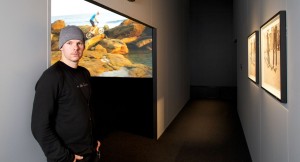 Turning to the work itself, would you like to pick one and talk about it?
Turning to the work itself, would you like to pick one and talk about it?
Maybe I could talk about a work that has a few different parts to it. One of the works I’m just calling Parallels. It’s a title that encompasses quite a few channels of video, and it looks at a range of different movements but usually it’s chasing one of these themes that I really love which is bodies on vehicles or moving through space and the whole kind of repetition or recurrence in the video is these two figures and they’re driving or in various vehicles, and they’re recording each other. So there’s no kind of crew and no performer. The performer is the cinematographer, and both figures are capturing each other moving through space in parallel. So all of these videos are showing two figures in two vehicles moving in parallel through some kind of environment. So it starts off with these two helicopters that are flying over French Island in [the Australian State of] Victoria, and you can see that these two helicopters are in the same space and there’s people hanging off them recording each other so you almost found yourself as if you were caught in the crossfire of these two cameras, these two gazes of subjects, and that’s quite a beautiful work to see these helicopters flying over this national park in the middle of this body of water. And then it moves to these two cars that I’m obsessed with, and this is where Ron Eagle who you met at Campbelltown kicks in. These two cars are the Mad Max replica cars, which I really love these Interceptor cars. It shows two people recording each other as these two cars are moving through a desert, and again that takes place with motorcycles, and then there’s another sequence which takes place with two figures on skateboards, but the thing is interesting is it’s a very basic contradiction that happens where you get these vehicles that are moving quite rapidly through space but their relationship to each other is fixed, like a zero relative speed, and I just love that look where you have a background that’s scrolling by but the cameras are looking at each other in relative stillness. It’s a really simple experiment, but it was quite nice to follow that experiment through all of these different vehicles that are all designed to tackle different kinds of spaces. So it was almost like a landscape survey and looking at this contradictory framing where you would have this stillness within speed as these people in vehicles traverse space. It is a really simple idea, like a lot of works I’m involved with. There is a really clear and simple action involved, whether that be looking at a whole range of bodies that are spinning in space; different kinds of spinning.
I saw in the shots ACMI sent me that you had a camera on a crane and it gave a birds’ eye view of people spinning on skateboards, or dancing (Vivienne Wong from the Australian Ballet.)
That’s right, that’s another project I’ve recorded for ACMI. It’s almost like an index or archive of different spinning movements. People riding bicycles, to skateboards, to capoeira to classical ballet. There’s an interest in how all of these different movements can involve a spinning action, and I love setting up a kind of almost comparative study between those two or three or four different kinds of spinning movements. So you can look at the relationships and the differences between the two.
That will be a multi channel video, installed in the ceiling so people watch them by laying down on the ground. It will be nice for people to relax and take a load off their feet. They’re going to be almost looking down at the images, even though they’ll be looking up at them. I really thought about how the viewer’s body would be more interesting to re-orient in relation to the screens.
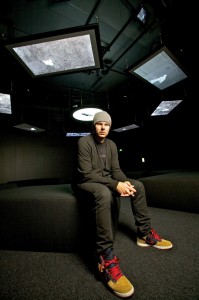 Vivienne Wong is from the Australian Ballet?
Vivienne Wong is from the Australian Ballet?
Amazing. She was great to work with.
How did you get on to her?
I’ve just been a fan of hers. I’ve watched her dance a few times. She’s been receiving all these awards, she’s just a bit of a star. I just wanted to work with her because she has such great form, technically she’s just astounding as a dancer. What I was after was asking her to do something very different to what she would normally be involved in which is a whole choreographed dance piece. I was just interested in one or two pirouettes. So when she came to the studio she already heard this idea that I had and she just performed these different versions of spins so she would be part of this community of spinning bodies.
Have you seen her dance with the Australian Ballet?
Yeah, it was great. She’s quite a star at the moment. It was great to see her dance for this project as well, because some of the forms of movement aren’t normally associated with an idea like grace, for example. Like capoeira is really quite graceful in its own way, but classical ballet has a particular kind of movement that people associate with balance and grace and whatever and it was quite strange to see it from a bird’s eye view, because it was kind of a leveling strategy where all of these spinning forms are shot from this unusual angle.
Were you a performer in it?
Yeah, I did have a spin on a skateboard.
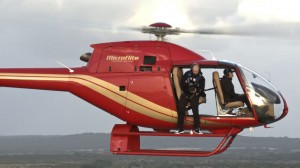 You were one of the ones on the helicopter as well?
You were one of the ones on the helicopter as well?
Yeah, that was a lot of fun.
Scary?
Yeah, I mean we were kind of fairly high up but it was such a wild experience physically because we didn’t want to shoot it on a calm day, it made sense to shoot it with like a bit of a wind and that was kind of nice. You can’t really see it in the video but there was this kind of a little bit more drama involved in shooting the work with the helicopters without doors on with this wind, so it was quite an experience to be up there and battling the elements.
Is the ACMI work all done?
Oh, I always tend to keep working on it right up until the last minute. Even though the work doesn’t involve huge amounts of editing, it’s always a labour intensive process because I never leave it, I always readjust it and change it and grade it. That side of the process I really love; after the image has been captured, this slight manipulation of the work. I love that. It’s quite nice seeing these Australian landscapes on my computer screens in London. It’s not so much a homesick experience, but it’s quite nice to still be connected.
Elizabeth Fortescue, June 4, 2011

Stop Press: New appointments at the Art Gallery of NSW
May 25th
Wayne Tunnicliffe has just been announced as the new head curator of Australian Art at the Art Gallery of NSW, replacing Barry Pearce who retired in February and who is now located at the Brett Whiteley Studio. Wayne was previously curator of contemporary Australian art at the gallery.
The gallery also announced the appointment of Kirsten Downie as assistant director, marketing, development and membership. Kirsten was previously head of marketing and communications at the National Gallery of Australia.
Follow this link to the gallery’s media release.
Elizabeth Fortescue, May 25, 2011
